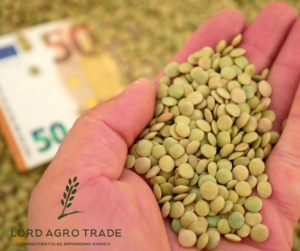Gulfood
17 To 21 FEB 2025 | DUBAI WORLD TRADE CENTRE
We’re excited to see you at Gulfood 2025!
Gulfood
17 To 21 FEB 2025 | DUBAI WORLD TRADE CENTRE
We’re excited to see you at Gulfood 2025!


Canada is the world’s largest exporter of lentils and legumes, with quality production catering to global demand. This agricultural sector is behind basic commodity production and exporting in many ways. Canadian lentil pricing has become one of the major focal points among exporters who wish to grab opportunities in the region of South Asia, the Middle East, and Europe. Canadian lentils have not only a higher quality but also consistency in their supply over the years, and this makes buyers from other countries confident in buying from them.
Canadian lentil pricing for export is not without its challenges, however. Exporters have to put up with fluctuating production costs, changing global demand for lentils, and the impact of exchange rate volatility. Besides, understanding the preferences and expectations of foreign buyers further complicates the pricing process, hence the call for a strategic approach to pricing Canadian lentils. Good, relevantly effective, and strategically important to the Canadian lentil price needs to be set on time so that exporters continue staying competitive in overseas markets.
Accurate pricing will see producers fairly compensated in Canada yet attractive to buyers overseas. Meeting this challenge means Canada remains well-positioned as a major lentil-legume supplier in the international marketplace. Mastering the price of Canadian lentils not only reinforces profitability but also strengthens strategic market presence. It is a vital ingredient in the continuing success of Canada’s agricultural exports, reinforcing its position as a global leader in the lentil industry.

The pricing of Canadian lentils for export involves a complex knowledge of various key elements that directly impinge on the all-important aspects of overall cost and competitiveness in world markets. These elements not only configure pricing strategies but also spell the profitability and sustainability of the lentil export industry in Canada. The key factors to be considered are highlighted below.
Product Quality: The Role of Grade and Quality in Pricing
Generally speaking, one major determinant of the Canadian lentil price in world markets is its quality. According to size, color, moisture, and purity, grading will occur for lentils. Top-quality lentils, unblemished by defects and free of contaminants, ensure better prices on world markets.
Buyers from the Middle East or South Asia often value quality over quantity. Given this scenario, Canadian exporters have to maintain the highest possible quality standards for their lentils. High-quality lentils mean assured and continuous demand, enabling one to quote competitive prices.
Production Costs: Agriculture, Processing, and Packaging lentils
The cost of production for lentils, which includes agricultural inputs such as seeds, fertilizers, and labor, is central to determining export prices. In addition, processing and packaging costs must be added. Modern processing facilities and efficient farming techniques can help reduce production costs, enabling exporters to offer competitive prices without compromising quality. However, an increase in the cost of labor or energy directly affects pricing strategy and challenges competitiveness.
Costs of Transportation: Geographic and Logistic Considerations
Canada’s broad geography and distance from most major export markets make the cost of transportation a crucial element in Canadian lentil pricing. It is no small freight cost to send lentils from the central production areas of Saskatchewan and Manitoba to almost any international market. Shipping options, like rail, truck, or by sea, add to costs. Lower transport costs are achieved through efficient logistics and/or access to large ports-reward buyers with better prices while maintaining healthy margins for exporters.
Global Demand: Influence of Target Markets and Trends
Global demand for lentils is heterogeneous across different markets, which are shaped by population growth, changes in dietary preference, and seasonal consumption. For example, demand from countries like India, which imports a lot from Canada, may increase at certain times of the agricultural cycle or during specific festivals. Changes in demand due to weather or geopolitical events also have an immense impact on export pricing. This will involve keeping abreast of market trends and adapting to the ever-changing demands of the market in setting competitive yet profitable prices.
Fluctuations in Exchange Rates: The Role of the Canadian Dollar
What turns the ball is the value of CAD, much higher versus other currencies, such as the US dollar or the Indian rupee. A high value for CAD raises the price paid for Canadian lentils by international buyers which could lower competitiveness. The weak CAD can offer a pricing advantage and thereby provide a squeeze on profit margin because of rising production costs. These risks can be mitigated by monitoring exchange rate trends and utilizing hedging strategies to provide stability in pricing and predictability.
Understanding and managing these factors enables exporters to create effective pricing strategies, balancing cost efficiency with market competitiveness. Addressing these considerations means that Canadian lentils stay preferred in international markets, hence consolidating Canada’s position as a global leader in lentil exports.

Import tariffs placed by destination countries have been significant in determining the final price of Canadian lentils in the world markets proceeding from a country of final destination. Governments usually impose arbitrary tariffs according to prevailing policies regarding imports and existing bilateral or multilateral agreements.
High Tariffs: India, often termed as the largest market for lentils from Canada, has sometimes levied high import duties to protect its domestic agriculture. This means higher prices for Canadian lentils. It makes them less competitive with those from other sources, local or otherwise, thereby bringing reduced purchases from these sources.
Low or Nil Tariffs: Free trade agreements, like CETA with the European Union, give room for reduced or even zero tariffs. This enhances competitiveness for Canadian exporters as well as market access and demand.
In most cases, exporters seek alternative markets or new price structures to smear the extra costs assumed to be the result of high tariffs instead of limiting their competitiveness.
Export Provisions: Limits and Chances in Canadian Trade Policies
These trade regulations that govern the export of Canada play a huge role in designing a lentil price policy. Those regulations were developed to ensure the quality of products, match international standards, and take earlier commitments made by the country among much larger trade objectives. Here are some constraints and the possibilities created by such regulations in the area of Canadian trade policies.

Exporters of Canadian lentils and legumes need to be strategic in terms of pricing in order to ensure that profitability and competitiveness are well-balanced. Below are practical tips addressing key areas of Canadian lentil pricing and helping exporters achieve success in global markets:
Structuring Pricing Contracts with International Buyers
Well-defined pricing contracts are critical in order to maintain transparency and build trust with international buyers.
Clarity in Pricing Terms: Clearly spell out the pricing basis, whether it is FOB, CIF, or DDP. This will avoid a lot of misunderstandings regarding responsibilities and costs.
Incorporating Flexibility: Include clauses related to currency fluctuations, changes in freight costs, or unexpected tariffs. This would help both parties adapt to market uncertainties without major disputes.
Volume Discounts: Tiered pricing with respect to order volumes encourages bulk purchases while avoiding shrinkage of profit margins.
Payment Terms: Lay down secure and favorable terms for the clients, like letters of credit or escrow arrangements that provide assurance against financial risks.
Leveraging Market Intelligence in Competitive Pricing
Global competition depends on the market’s best practices for price determination.
Global Market Trends: Receive constant updates on demand-supply dynamics in target markets, which could be seasonal demand arising in India or emerging opportunities arising in European markets.,
Competitor Analysis: Keep track of competitors’ pricing strategies for huge exporters like Australia or the United States Canadian lentils at globally competitive prices.
Production Cost Analysis: Have correct production, processing, and logistic cost data to arrive at a base price that gives reasonable profit without being uncompetitive.
Dynamic Pricing Models: The use of technology-driven tools and software that will permit changing the price in real-time due to changes in market conditions or changes in input costs.
Researching Target Markets: Understanding Consumer Preferences
Clearly, an in-depth understanding of target markets is of high importance for pricing and marketing strategies.
Cultural and Dietary Preferences: Know which type of lentils (for example, red in India, green in Europe) is normally consumed. Price in relation to perceived value in a market segment.

View products: Red Lentils | Red Split Lentils

View products: Green Lentils
Market-Specific Packaging: A few markets would favor a smaller, retail-friendly kind of packaging, while there are others that may demand bulk shipments. Pricing must accommodate these preferences and added packaging costs.
Economic Sensitivity: The overall purchasing power and sensitivity towards prices among the target market participants. For instance, price elasticity can radically differ between rich European markets and sensitive South Asian markets.
Building Relationships and Trust in Export Markets
Relationships with overseas buyers and distributors play an important part in successful pricing.
Long-Term Contracts: Have long-term agreements with identified key buyers for continuous demand and price stability.
Quality Assurance: The quality of the products has to be consistently high to keep the trust and justify the premium pricing.
Communication: Keep the line of communication open with buyers to promptly address their concerns and adjust the pricing strategy accordingly.
Overcoming Regulatory and Logistic Challenges
Practical ways to overcome logistical and regulatory challenges:
Customs and Compliance: Be compliant with import regulations and certifications required by the target market to avoid delays or penalties that may affect pricing.
Optimized Logistics: Work with reliable logistics partners to minimize transportation costs, allowing competitive pricing without compromising profit margins.
Hedging Currency Risks: Use financial tools to hedge against exchange rate fluctuations, stabilizing export pricing in volatile markets.
Conclusion
Canadian lentil pricing is one of the major factors that determine success in exports within the competitive global market.
If Canada is to continue its leadership in the exportation of lentils, then there must be dynamic and timely pricing strategies. Product quality, cost of production, transport cost, global demand, and trade policies are all influential factors in price determination. Address these positively, and this ensures competitiveness at prices without sacrificing profitability.
Volatility in the market, fluctuations in currency, and high logistics costs are continuous challenges that demand exporters be more proactive in diversifying their markets, managing risks, and utilizing trade agreements. Furthermore, it requires an understanding of the culture and economic subtlety of target markets to set prices with resonance among international buyers.
Besides competitiveness, strategic pricing reflects Canada’s commitment to quality, sustainability, and reliability in the global food supply chain. Well-structured contracts, market intelligence, and long-term relationship building will enable Canadian lentil exporters to overcome the complexities of world markets, adjust to changing conditions, and continue to drive growth in the sector.
Ultimately, a good pricing strategy means that Canadian lentils are preferred everywhere, contributing to continued profitability and further consolidating Canada’s reputation as a leader in the supply of quality lentils and legumes into world export markets.